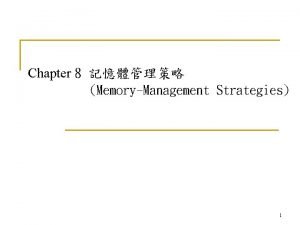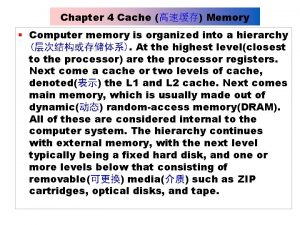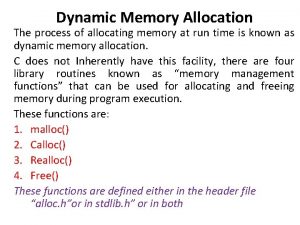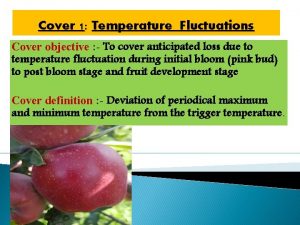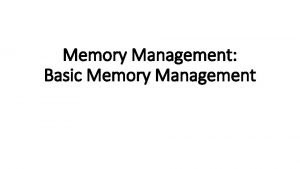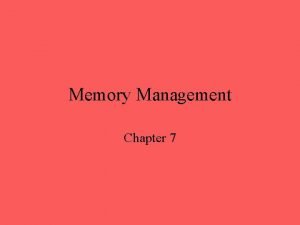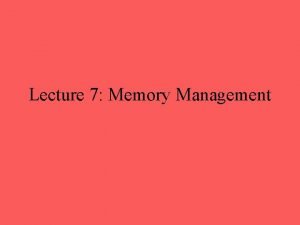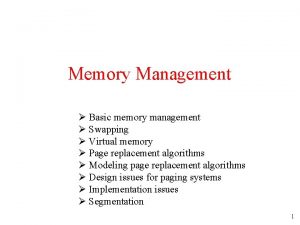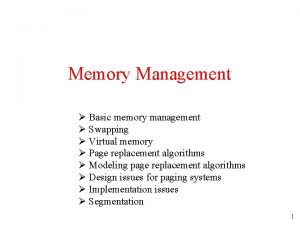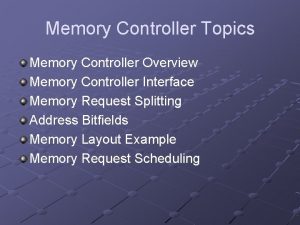Memory Management To cover Overview Strategies for Allocating
































- Slides: 32

Memory Management

To cover • Overview. • Strategies for Allocating Variables to Memory. • Design Patterns for Limited Memory. • Memory Management in Mobile Java. • Symbian OS Memory Management.

Overview • Memory management is different from managing some other resources • Tangling everywhere • Mobile devices memory is a critical resource - cost of the device low - running programs are competing for it • Explicitly allocate memory in many imperative languages, such as C and C++ • Memory consumption in mobile devices a crosscutting problem

Strategies for Allocating Variables to Memory • Stack and the heap are principle memory areas • Run-time infrastructure and the programmer are responsible for their management • In heap, sharing of data is easy and natural • Stack-based variables references should use with care - stack increases and decreases, and may overwrite referred data • Statically allocated to a permanent location or dynamically allocated from stack or heap

Static Allocation • Throughout program life variable remains allocated • Memory locations used by it cannot be deallocated. int * pointer_to_static() { static int x; return &x; } • Singleton pattern - a single instance (or a few instances) of a class, and make it known to all subsystems.

Stack • Transient objects - Those that live only a limited period of time, are to be stored in the stack. int * pointer_to_int() { int x; return &x; } • Returned reference points to a location in the memory • Potentially overwritten by any later functions that will be called by the program



Stack Limitations • Hard-to-repeat errors and complex debugging tasks. • Stack could exhaust when data is accidentally copied by making a method or function call • Better to allocate big objects from the heap • to ensure that the object is not accidentally modified via a reference, const definition can be used where applicable

Heap • All data structures whose size or structure can be altered dynamically must be allocated to the heap. • Since, unknown structures are impossible to reserve enough space from the stack. • Global object, should be allocated memory from heap. • garbage collection is a responsibility of the caller if there is no automation • Heap can be slower than using the stack

Design Patterns for Limited Memory • Design should be based on the most adequate data structure, which offers the right operations. - Use singly link list instead double if it is enough. • Better performance if support can be gained from cache. • Design patterns created for help in designing small memory software. • Linear Data Structures: - Where different elements are located next to each other in the memory. - For instance, implementations of lists and tree-like data structures. - Linear data structures are generally better for memory management than non-linear ones.

Design Patterns for Limited Memory • Less fragmentation: - Linear data structures occupy memory place from one location. - whereas non-linear ones can be located in different places. - Obviously, the former results in less possibility for fragmentation. • Less searching overhead: - Reserving a linear block of memory for several items only takes one search for a suitable memory element in the runtime environment - whereas non-linear structures require one request for memory per allocated element. - Combined with a design where one object allocates a number of child objects, this may also lead to a serious performance problem.

Design Patterns for Limited Memory • Design-time management: - Linear blocks are easier to manage at design time, as fewer reservations are made. - This usually leads to cleaner designs. • Monitoring: - Addressing can be performed in a monitored fashion, because it is possible to check that the used index refers to a legal object. • Cache improvement: - using linear data structures, it is more likely that the next data element is already in cache

Design Patterns for Limited Memory • Index uses less memory: - An absolute reference to an object usually consumes 32 bits, - whereas by allocating objects to a vector of 256 objects, assuming that this is the upper limit of objects, an index of only 8 bits can be used. - Furthermore, it is possible to check that there will be no invalid indexing.

Design Patterns for Limited Memory • Basic Design Decisions: • Allocate all memory at the beginning of a program. - Reserving all the resources is particularly attractive when the most important or mandatory features like emergency calls • Allocate memory for several items, even if you only need one. - a number of objects is reserved with one allocation request. - less complex structure in the memory. - fewer memory allocations, and cache use is improved. • Use standard allocation sizes. - easy to reuse a deallocated area in the memory. - fragmentation of memory can be prevented.

Design Patterns for Limited Memory • Reuse objects. - programmer actively participates in the process of selecting object construction and destruction policy • Release early, allocate late. - objects occupying a large amount of memory are deallocated before allocating new objects. • Use permanent storage or ROM when applicable. - in case of battery removal from the device, unsaved data will be lost - save all data to permanent storage as soon as possible. • Avoid recursion. - size of a single stack frame in KVM is 28 bytes (7× 4 bytes). - functions calling themselves recursively can end up using a lot of stack

Design Patterns for Limited Memory • Data Packing - way to reduce memory consumption. • Consider word alignment. struct S { char c 1; // Actually a boolean. int i; char c 2; }; - three words are required - By changing the data structure to struct S { char c 1; // Actually a boolean. char c 2; int i; };

Design Patterns for Limited Memory - c 1 and c 2 fit in the same word. - improvement can be gained by using only one bit for the Boolean value, assuming that there would be some other data to include in the saved bits.

Design Patterns for Limited Memory • Use compression with care. - May impair performance while compressing data or opening files - three different compression techniques: - Table compression • also referred to as nibble coding or Huffman coding • encoding each element of data in a variable number of bits • so that the more common elements require fewer bits. - Difference coding • representing sequences of data according to the differences between them. - Adaptive compression • is based on algorithms that analyze the data to be compressed

Design Patterns for Limited Memory • Use efficient resource storage format. - ensure that images, sounds, and movies are stored in the most efficient way - possible to save some space by combining many image files into one image file.

Design Patterns for Limited Memory • Discussion - memory management are not problem-free. - when improving a certain property of software design, some other part is downgraded or compromised. • Increased minimal memory usage. - simplistic implementation. • Decreased flexibility. - it is possible that some hardware configurations are invalidated. • Downgraded performance. - Using some form of compression can lead to decreased memory use - packing a lot of information into the same memory word can lead to downgraded performance.

Design Patterns for Limited Memory • Longer initialization and shutdown sequences - it is possible to handle some of the operations associated with memory at the beginning or at the end of the program - rather than in the middle of the execution, startup and termination of the program can become slower. • Potential unintuitiveness in designs - When an experienced designer composes a design in a memory-aware fashion, - some of the decisions can be unintuitive to less experienced developers. • Impaired reusability - The more one addresses particularities of a certain design problem in the solution, - the less likely it is that the same solution could be used again in another context.

Design Patterns for Limited Memory • To summarize, it is a necessity to balance between the different requirements addressing the properties of designs.

Memory Management in Mobile Java • Code optimization could be error prone - Such systems running on Virtual Machines - May cause abstraction leakage • Motivation - Despite of managing resources automatically, use appropriate data structures (garbage collection using DS) - For instance, implementing a stack of references on a virtual machine - The stack is implemented as a vector. - An index (size) to the vector is used as the stack pointer - Stack pointer is incremented by one, when a new item is added. Public void push(Object e) { ensure. Capacity( ); // Check that slots are available. elements [size++] = e; }


- Similarly, when an element is removed from the stack, the stack pointer is decremented by one. public Object pop(){ if(size == 0) throw new Empty. Stack. Exception(); return elements[--size]; } - Reference to garbage collection, there can be ‘ghost’ references to objects that are unusable - but remain valid and accessible in the vector used in the implementation. - Such ‘ghosts’ are a result of executing several push and pop operations. - The garbage collector is not allowed to deallocate them before the last reference to them has been erased, and having an accidental unused reference counts in this respect.

- the problem can be solved by setting vector element to zero in method pop: public Object pop() { if(size == 0) throw new Empty. Stack. Exception(); Object result = elements[--size]; elements[size] = null; return result; }

Rules of Thumb for Mobile Java • Avoid small classes. - it is better for memory consumption to merge small classes into bigger ones. - Usually inner classes contain only little functionality, like a particular listener of some user action. - keeping the number of different exceptions as small as possible. - For instance, the memory consumption of an application that was implemented using two different structural alternatives, shrank to almost half from 14 019 bytes to 7467 bytes when the number of classes was reduced from 14 to 1 without altering the behavior of the application (Hartikainen et al. 2006). • Avoid dependencies. - one might save memory by removing references

• Select the size when relevant, and manage vector/string usage. - whenever possible, by providing the size of the vector instead of using the default size • Consider using array versus using vector. - the difference between array- and vector-based implementations is relevant both in terms of the number of objects and used bytes. - vector effectively need to wrap integers to objects to be able to store their values - an implementation where the correct size is given in the constructor, allocates up to 24% less memory in terms of size.

• Use String. Buffer. - Concatenating String with the + operator or with the append method consumes memory as the virtual machine needs to create temporary objects. - Using strings Using String. Buffer // String based implementation. public void use. String() { String s = ""; for(int i = 0; i < AMOUNT; i++) { s = s + "a"; } } // String. Buffer based implementation. public void use. String. Buffer() { String s = ""; String. Buffer sb = new String. Buffer(AMOUNT); for(int i = 0; i < AMOUNT; i++) { sb = sb. append("a"); } s = sb. to. String(); }

• Manage class and object structure. - Inheritance can sometimes cost memory - When creating an object of a child class also its parent class needs to be loaded - All the variables from the parent are present in a child object - hierarchy of classes constructed can lead to superfluous loading and memory consumption. • Generate less garbage. - Reusing old objects to avoid making garbage. • Consider obfuscation. - majority of the content of a Java library often consists of metainformation and strings. - one can reduce footprint by obfuscating the names of public instance variables and methods, classes, and packages to a smaller form.

• Handle array initialization. - Long arrays static initializer can consume a lot of space - Improved tool support can offer solutions that consume less memory. - In practice, the difference only becomes meaningful when the size of an array is over 1000 (Hartikainen, 2005).
 The allocation map
The allocation map Markets allocating resources
Markets allocating resources Modification of alloc algorithm for allocating disk block
Modification of alloc algorithm for allocating disk block Memory management strategies
Memory management strategies Cover uncover test vs alternating cover test
Cover uncover test vs alternating cover test Vike vicente
Vike vicente Forced duction test procedure
Forced duction test procedure Computer memory system overview
Computer memory system overview Computer memory system overview
Computer memory system overview Spreading activation psychology
Spreading activation psychology Implicit and explicit memory
Implicit and explicit memory Long term memory vs short term memory
Long term memory vs short term memory Internal memory and external memory
Internal memory and external memory Primary memory and secondary memory
Primary memory and secondary memory Logical and physical address in os
Logical and physical address in os Which memory is the actual working memory?
Which memory is the actual working memory? Virtual memory and cache memory
Virtual memory and cache memory Virtual memory in memory hierarchy consists of
Virtual memory in memory hierarchy consists of Eidetic memory vs iconic memory
Eidetic memory vs iconic memory Symmetric shared memory architecture
Symmetric shared memory architecture Kontinuitetshantering
Kontinuitetshantering Typiska drag för en novell
Typiska drag för en novell Nationell inriktning för artificiell intelligens
Nationell inriktning för artificiell intelligens Vad står k.r.å.k.a.n för
Vad står k.r.å.k.a.n för Shingelfrisyren
Shingelfrisyren En lathund för arbete med kontinuitetshantering
En lathund för arbete med kontinuitetshantering Adressändring ideell förening
Adressändring ideell förening Tidbok för yrkesförare
Tidbok för yrkesförare Anatomi organ reproduksi
Anatomi organ reproduksi Densitet vatten
Densitet vatten Datorkunskap för nybörjare
Datorkunskap för nybörjare Boverket ka
Boverket ka Mall debattartikel
Mall debattartikel



